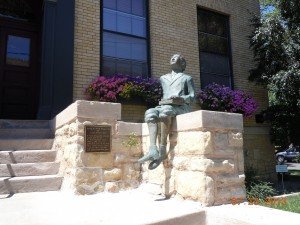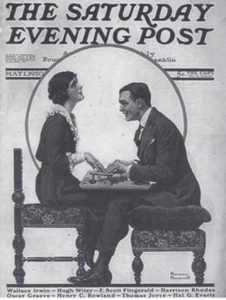Trips Into History had the opportunity to visit the St. Paul Academy in St. Paul Minnesota, well known as being a school attended by F. Scott Fitzgerald, a famous American writer of short stories and novels.

In all, Fitzgerald finished four novels. These included This Side of paradise, The Beautiful and the Damned, Tender is the Night and The Great Gatsby. His fifth novel, The Love of the Last Tycoon was published after his death in 1940.
Today’s generation might recognize several of Fitzgerald’s works as they have been made into popular films.
Visiting St. Paul Academy and Historic Summit Hill
The St. Paul Academy is an interesting stop to make if your travels take you to the Minneapolis / St. Paul area.
In addition to visiting the school where Fitzgerald attended, you may be able to take a unique walking tour which includes the house where he was born (481 Laurel Ave.) in 1896 and the site where he wrote his first novel. Fitzgerald was born at this address in a third floor apartment. On this tour you’ll also be able to take in Summit Avenue which dates back to the 1850’s with it’s historic houses and churches. Summit Avenue is both a National Historic District and a City of St. Paul Heritage Preservation District.

For more information regarding tours of St. Paul’s historic Summit Avenue you may want to visit the website www.mnhs.org/historic-sites/james-j-hill-house
The James J. Hill House is located at 240 Summit Avenue and was the home of James J. Hill, founder of the Great Northern Railway.
F. Scott Fitzgerald of St. Paul Minnesota
F. Scott Fitzgerald, whose formal name was F. Scott Key Fitzgerald, attended St. Paul Academy from 1908 to 1911 after his father had moved from Buffalo New York to St. Paul Minnesota. Fitzgerald’s father tried manufacturing wicker furniture in upstate New York without success. He did find a job as a salesman for Proctor and Gamble in Minnesota and this necessitated the family’s move to St. Paul.
Interestingly enough, Fitzgerald’s first published writing came at the age of thirteen when he wrote a detective story for the St. Paul Academy newspaper. His stay in St. Paul at this early period of his life was short. Fitzgerald was actually expelled from St. paul Academy in 1911 for what was said poor grades. Aside from his writing, the future author apparently didn’t give the effort required for the rest of his studies.

The family moved to New Jersey in 1913 where the young Fitzgerald attended the Newman School from 1911 to 1913 and then it was Princeton University from 1913 to 1917. F. Scott Fitzgerald ended up dropping out of Princeton and joined the U.S. Army as a second lieutenant.
Writing Style of F. Scott Fitzgerald
Many claim that F. Scott Fitzgerald was one of America’s greatest writers. Describing the writing style of F. Scott Fitzgerald includes many elements. It certainly cannot be described in one word. You have to consider the time period of which his writings took place. Some may consider his work of “drawing room” style. His sentences tended to be complex. This would be different from Hemingway’s more down to earth writing. Some might call Fitzgerald’s writing a bit pompous and at times judgmental. His characters were not always heroes.
The decade of the 1920’s was especially influential to Fitzgerald. You can readily see this in The Great Gatsby which was published in 1925. This was one of his shorter stories. Three of his works were published during the 1920’s. During this period he also built a relationship with Ernest Hemingway.

Fitzgerald used class differences in his writings. The difference between the lives of the high social class as opposed to that of the poor. You certainly see this same theme in later writings such as The Grapes of Wrath by John Steinbeck.
F. Scott Fitzgerald died suddenly in 1940 of a heart attack in Hollywood California.
You may also enjoy two articles on our Western Trips site on the links below…
The John Steinbeck Center in Salinas CA
Jack London State Historic Park
For those wanting more insight into the writings of F. Scott Fitzgerald, I have to mention an ebook publication entitled Who Was F. Scott Fitzgerald’s Daisy? The character Daisy was the leading lady in The Great Gatsby. In this book local author Andrea Olmstead identifies the real life woman and her relationship with Fitzgerald. Olmstead explains how this woman influenced characters in This Side of Paradise and Tender is the Night.
(Article and photos copyright 2013 Trips Into History. Saturday Evening Post image is from the public domain)
